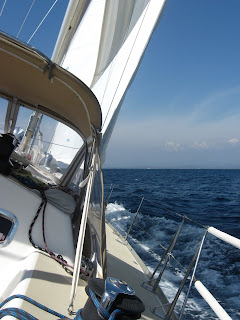 Heading out to sea to avoid some nasty rocks strung out from the coast, we raise sail as winds pick up and keep picking up. Afternoon winds do that down here, but these are early. We are sailing upwind in 20 – 25 knots of winds. The First Mate stays at the helm until the sun is too much for her. She is never going to fully learn to sail if they keep turning on the autopilot! It was a glorious sail, but 5 knots less of wind or less turbulent seas would have been more comfortable.
Heading out to sea to avoid some nasty rocks strung out from the coast, we raise sail as winds pick up and keep picking up. Afternoon winds do that down here, but these are early. We are sailing upwind in 20 – 25 knots of winds. The First Mate stays at the helm until the sun is too much for her. She is never going to fully learn to sail if they keep turning on the autopilot! It was a glorious sail, but 5 knots less of wind or less turbulent seas would have been more comfortable.
 It takes us 5 tries to set the anchor in Bahia de Navidad. It keeps skipping along the gravel and rocky bottom and will not grab. Finally, we feel that comforting tug as we back down. The anchor is set. With rocks not far from us, we are very glad to set the anchor alarm.
It takes us 5 tries to set the anchor in Bahia de Navidad. It keeps skipping along the gravel and rocky bottom and will not grab. Finally, we feel that comforting tug as we back down. The anchor is set. With rocks not far from us, we are very glad to set the anchor alarm.
We are on Central Time here in this part of Mexico. It is hard for The First Mate to comprehend that until she looks at a map. We really are that far east! However, we are on the western edge of the time zone. Sunrise comes late here. It is still dark at 7:00 in the morning. Being one who tends to wake with sunlight, The First Mate finds she is sleeping later until 7:30 or even 8:00. Not so The Captain. He has a different internal clock, that’s all. Up before the sun, he looks around outside and sees a sailboat anchored behind us that must have come in at some point during the night. It certainly was not there when we went to bed. It is a beautiful boat and a beautiful sight set off against the rising sun. 
7:22 am – Bahia de Navidad
This boat is the most beautiful we have ever seen. About 75’ long, it is all wood and shines in the sunlight.  It is sleek and classic, made to sail the seas. As we head out of the bay, we circle near to see if we can pick up its name and identify from where it hails. We can do neither, but The First Mate decides to capture a few more pictures of this elegant beauty.
It is sleek and classic, made to sail the seas. As we head out of the bay, we circle near to see if we can pick up its name and identify from where it hails. We can do neither, but The First Mate decides to capture a few more pictures of this elegant beauty.
Needing a fax machine, we are heading into Grand Bay Marina which is at the end of a narrow dredged channel. Once again, we are at a full moon with super low low tides. The Captain tries to raise the marina to verify the depth of the channel, but no one answers. We decide to trust the published data and inch our way thru the channel. It poses no problem. The marina is another matter. We are assigned a slip that at first we cannot locate and when we do, from what we can see, it looks like our slip is in a corner without sufficient turning radius to get into it. This marina does not send anyone out to guide or help us as other marinas have done. The “French Baker” in his panga making his morning deliveries checks it out for us and tells us that there really is room though we cannot see it from our angle. Slowly, more slowly than when we inc hed down that channel, The First Mate moves Avante down the fairway. Sure enough, there is room, but it is close. Lines tied, engine off, boat secure ...both Captain and First Mate are relieved. We now take the time to look around. What a beautiful marina and what a great hotel above it all! Another neat place – this one with palm trees in abundance!
hed down that channel, The First Mate moves Avante down the fairway. Sure enough, there is room, but it is close. Lines tied, engine off, boat secure ...both Captain and First Mate are relieved. We now take the time to look around. What a beautiful marina and what a great hotel above it all! Another neat place – this one with palm trees in abundance!

We take care of what business we can and then decide to explore the little town of Barra. To get there, one takes a water taxi across the channel. What fun!
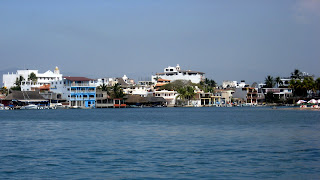
Approaching Barra, it reminds us of an island version of Venice. Imagine a gondola instead of a panga with an engine. All we need is a gondolier with a Pavarotti voice!
Back at the hotel, we enjoy a late afternoon swim in the pool. Refreshed and spruced up, we take the water taxi back to Barra and then a real taxi to Melaque, the town that is on the bay where we had anchored the previous night. Having had such a miserable dinner at that restaurant in Manzanillo, we are feeling a little gun shy, but the hotel concierge assures us that this restaurant in Melaque is very good. Our taxi driver also approves. We are feeling better. We arrive at the restaurant. There is not a light on. Monday night – it is closed! Now what to do? We ask the driver for a recommendation. Should we go back to Barra? No, there are no good restaurants there. Melaque has the best. He points to one across the street and says that it is very good. What else to do? Off we go, and we have a very good dinner with a delightful waiter accompanied by live music. It is amazing how one bad experience can have such a negative impact, but with this one very good experience, we are now feeling much better about dining out “on the economy”, as we used to say when we lived in Spain and Italy.
Tuesday, February 10th – The First Mate is up and ready. It is “French Baker” time. Finally, she hears him announce his arrival on the radio. Making contact, she requests that he stop at slip A-11. Avante is the name of the boat. He motors over with a panga filled with bakery goods, French bakery goods. She buys 2 croissants (chocolate for her, almond for him), 2 baguettes and a strawberry tart for tonight. Over our cappuccinos, we savor those croissants.
Today, our destination is Bahia de Tenacatita or Ten Bay in cruiser-speak. It is only 21 miles up the road, and then we will have 3 Savor Days. (That’s 5 so far if anyone is counting!) Ten Bay is a large bay, but it is quiet with little development. One of its features is a self-guided jungle river trip which runs thru a mangrove marsh. Turn off your engine and drift with the current. Listen to the wildlife. Search out the bright red crabs on the mangrove roots. Hunt for the birds among the foliage. We so enjoyed our trip that we went twice. Once in the early morning and then again in the evening.

Entering the river lined with mangroves.

We are soon drifting under a mangrove canopy thru shade and dappled sunlight.
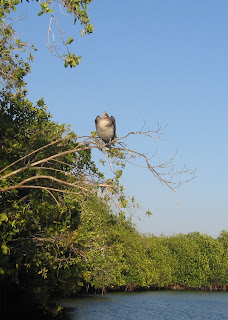
Pelicans actually roost in trees! This strange sight is a pelican asleep on his branch. We are sitting quietly in The Dingbat as we drift silently under his perch.
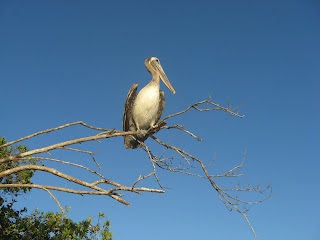
Ever watchful and alert even in sleep, he senses our presence.
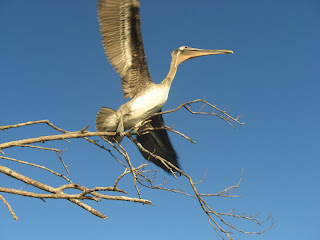
“No sleep for the weary,” he mutters to himself and off he flies.
Thursday, February 12th – We walk the beach in the morning! We snorkel! We explore the Jungle River in the late afternoon! “What a perfect ‘Savor Day’”, thinks The First Mate. “Not bad for a ‘Do Nothing Day’”, thinks The Captain.
Friday, February 13th – Though we have been told that anchoring in Bahia Careyes m ay not be possible for our size boat, we head out to give it a try. If nothing else, we want to see this up and coming “Mexican Riviera” with its many multi-colored homes climbing up the rocky shore. Again there is a good wind, and The First Mate takes the helm and stays there.
ay not be possible for our size boat, we head out to give it a try. If nothing else, we want to see this up and coming “Mexican Riviera” with its many multi-colored homes climbing up the rocky shore. Again there is a good wind, and The First Mate takes the helm and stays there.
The only criticism I have about the J/160 is that it was not designed for a 5’5” person. Everything is about 3” too big, t oo tall or too wide for me. All this stretching and reaching out to count for something, one would hope!
oo tall or too wide for me. All this stretching and reaching out to count for something, one would hope!
Here I am on tiptoes trying to see over the dodger.
Arriving at the bay entrance, we take down the sails and motor between two rocky outcroppings into the bay. It is small, and though it actually comprises 3 bays in a clover shape, none of them have room for us. We anchor out in the middle to take in the view, but with the seas up, the wind barreling down on us and a huge rocky coast a few 100’ behind us, this is not a tenable anchorage for the night.

Approach to Bahia Cayeres. Prime real estate down here with luxury homes in a multitude of bright colors.

As we were told, it is a very pretty spot. What a fantastic beach ringed with palm trees! It would be great to visit, but conditions just will not allow us to stay.

These rocks, less than a few 100’ behind Avante’s stern, are a good reason why we choose to leave this windy, rolling anchorage. If the anchor slips, we would have very little time to get up on deck, start the engine and get the heck out of there.

The Captain enjoys the view before we reluctantly pull anchor and head 10 miles up the way to Bahia de Chamela.
By the time we are out of the bay and into open water, winds are averaging around 18 knots and the seas are quite turbulent. The Captain decides that we will motor rather than raise sail to tack back and forth the 10 miles we have to go. It proves a timely decision, for within a half hour of raising sail we would have been going thru a first reef maneuver as the winds climbed over 20 knots. Within a half hour of that, the second reef would have had to be put in with winds clocking in at 28 to 30. It is not that we could not have sailed. It is just that it would have taken so much longer to tack those 10 miles, and it would have been a good deal more uncomfortable than the wave bashing we were currently receiving.
As we finally motor into Bahia de Chamela, we expect the winds to drop within the shelter of the headland. They do drop – to a mere 20 – 22 knots. Anchoring in such winds in rolling seas is always a challenge. At the helm, it becomes a matter of putting just enough power on to hold the boat in place until the anchor hits the bottom. Too much power, and you overrun the anchor. Too little, and you end up way down from your intended anchor spot and thus possibly too close to boats behind you. It is a bit of a dance out there, made worse by the anchor refusing to set firmly and skipping over either rocks or gravel down there. Twice we back down on the anchor. It grabs briefly before pulling loose. On the third attempt, it catches. We’re done. With the wind still howling and barreling down on the anchorage, it is a relief to be secured.
Bahia de Chamela is the first good anchorage one reaches after rounding Cabo Corrientes heading south to the Gold Coast, which in reverse makes it the last good anchorage before heading back up around Cabo Corrientes to Puerto Vallarta which is what we are now doing.. We are planning 3 Savor Days here. (That’s 8 and counting.)
Saturday, February 14th – We spend the morning involved in various projects and interests. After lunch just as we are about to launch The Dingbat for some exploration ashore, those afternoon winds pick up again. We are soon being blasted by 20+ knot winds just like yesterday’s and decide that a launch The Dingbat exercise is not necessary in this wind. Even though we know we are securely anchored, there is always a nagging concern when winds are this high. Added to this concern is the presence of a new boat that anchored much closer to us than we would have liked, especially in this wind and with the way both boats are swinging at anchor. We are not too pleased with this and decide that remaining on Avante to monitor the situation is a good decision. So, we go for a swim. It’s a Savor Day!
Sunday, February 15th – We get up early, launch The Dingbat and head ashore to enjoy a brisk morning walk to the near-by village. We purchase eggs, but on the way back, The First Mate convinces The Captain that breakfast in one of the beach restaurants would be preferable. We chose one with brightly colored checked tablecloths and order orange juice and omelets. Expecting reconstituted orange juice, we are surprised and delighted with soda fountain-sized glasses of freshly squeezed orange juice. The juice alone is a great breakfast. The omelets are delicious, too. With the total cost at $8.50, Th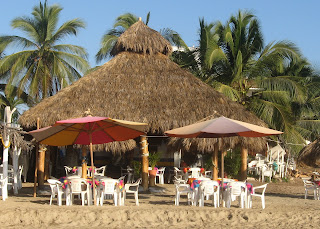 e First Mate declares the breakfast galley aboard Avante closed for the remainder of our stay here! Who can blame her? Fresh orange juice, beachside location, pelicans and other sea birds doing acrobatics out there, peaceful breezes – This is truly a Savor Day!
e First Mate declares the breakfast galley aboard Avante closed for the remainder of our stay here! Who can blame her? Fresh orange juice, beachside location, pelicans and other sea birds doing acrobatics out there, peaceful breezes – This is truly a Savor Day!
On the way back to Avante, we stop to visit with Kate and Greg James whom we had met in Canoe Cove in Canada last summer. They had bought an old Baltic 52 and had been at the boat yard for well over a year, lovingly and beautifully restoring her. “Sirius” was almost ready and they were planning to take off in July headed south to Mexico. Mexico is a small coastline, right? We knew we would meet up somewhere down here and sure enough here we are anchored almost side by side in Bahia de Chamela.
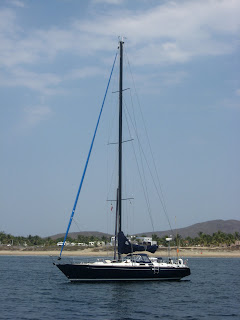
”Sirius” – Baltic 52” – at anchor in Bahia de Chamela
While we are comparing adventures as cruisers do, a dingy motors up to tell us that a barbecue picnic is being planned on the beach of one of the islands in the bay. All cruisers in the “fleet” in Chamela Bay are invited. Bring whatever you want to eat and drink, snorkel gear for the near-by reefs and whatever else you want to add to the fun. Sounds like a great time. We’ll be there, but first The Captain wants to move Avante. His excuse is that he wants to get closer to the headlands to be less exposed to these strong afternoon winds, but the truth is we have had enough of swinging too close to the boat that anchored so near us. Dreading another round of skipping anchor sets, we move, drop anchor and on the first try it bites in securely. Feeling so much better about this spot, we change into bathing suits, grab our gear and head off to the island.

We meet a great group of fun people, but in particular there is a couple from California with whom we had exchanged weather information by radio on the trip south to Cabo. Ines and Kirk Nyby are tandem sailing on their schooner “Pilot” with their son and his wife, Mindy and Tristen, on their catamaran. They are at the beginning of a yearlong cruise to the Pacific Islands, returning to Long Beach Harbor by way of Hawaii. This will be Ines and Kirk’s third ocean voyage. In the 70’s as a young couple, they were one of the first to circumnavigate on a catamaran. Then in the early 90’s after designing and building “Pilot”, they took their 3 children out of school for a year and, along with Ines’ parents sailin g on their own boat, undertook a cruise similar to the one they are doing now. Here they are today doing the same trip with their son and his wife. “What a great saga!” thinks The First Mate. Eager to learn more, she invites them to join us and the James for dinner the next evening at one of the beach restaurants. The James, as are we, are thinking about heading off to the Pacific Islands. This truly is a great Savor Day!
g on their own boat, undertook a cruise similar to the one they are doing now. Here they are today doing the same trip with their son and his wife. “What a great saga!” thinks The First Mate. Eager to learn more, she invites them to join us and the James for dinner the next evening at one of the beach restaurants. The James, as are we, are thinking about heading off to the Pacific Islands. This truly is a great Savor Day!
Monday, February 16th – A robust beach hike followed by another fresh orange juice and omelet breakfast. Cannot get any better! Only problem is that The First Mate has 2 blisters on her toes that developed from sand getting into the sandals and abrading the baby-fine skin of her toes. The Captain shakes his head in disbelief and amazement. He knows for a fact that she hardly ever has the right shoes for the right place, but here she is with right shoes (Keen water and hiking sandals) in the right place (beach) and she still gets blisters! What to do with her and her feet? Undeterred, she plasters on Band-Aids. What’s a small inconvenience on another great Savor Day?
We all meet later that evening on “Pilot” for cocktails before heading ashore for dinner. As The First Mate had hoped, it is a convivial group with a lot of information flowing back and forth. We have dinner at Manuelitta’s on the beach. We are the only group in the restaurant, and they are delighted to have us. So many restaurants on the beach and not a lot of evening clientele on a Monday night.
The Formula for Cruising is working nicely. Though The Captain continues to grouse about Savor Days, these Savor Days are adding a further dimension to our cruising. We are exploring more, doing more, getting on land more and meeting interesting people whose stories, adventures and plans are fascinating and informative. All of this adds to the richness of the Cruising Life. Would not miss it for the world!
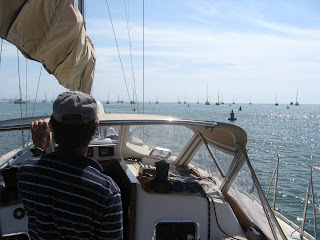 lightful, and we spend the afternoon recovering from our trip. Bill finds that the jib furler is easy to fix in daylight, when he is not being sprayed by every wave. It is close to dark when we finally launch the dinghy and head into town. There is a wonderful marina in La Cruz in the final stages of completion, but the road into town is all torn up. We trudge through the construction headed for Xocolatl, a restaurant that has been highly recommended to us. Not only is the food claimed to be good, the location is high above the town with a sweeping view of Banderas Bay. We find the restaurant but are dismayed to find a sign reading “Sorry. No credit cards”. We are out of pesos after our anchor adventure and here in the Puerto Vallarta area things are not as inexpensive as breakfast was in the remote anchorage of Bahia de Chamela. The owner offers to let us come back and pay tomorrow, but we are uncomfortable with that offer. One never knows what tomorrow will bring, especially on a boat. Since we do need to get cash sometime, we might as well get it now before sitting down to dinner. We ask where the nearest ATM is located, and the owner says the only one in town is at the gas station. He points at some lights down the road. Thinking he can make the trip faster by himself, The Captain suggests that The First Mate wait for him at the restaurant. Happily she does, sitting at a table overlooking the sweep of Banderas Bay, sipping a glass of wine, savoring the evening. The Captain returns almost an hour later eager for a beer. The gas station was 2 km down the road!
lightful, and we spend the afternoon recovering from our trip. Bill finds that the jib furler is easy to fix in daylight, when he is not being sprayed by every wave. It is close to dark when we finally launch the dinghy and head into town. There is a wonderful marina in La Cruz in the final stages of completion, but the road into town is all torn up. We trudge through the construction headed for Xocolatl, a restaurant that has been highly recommended to us. Not only is the food claimed to be good, the location is high above the town with a sweeping view of Banderas Bay. We find the restaurant but are dismayed to find a sign reading “Sorry. No credit cards”. We are out of pesos after our anchor adventure and here in the Puerto Vallarta area things are not as inexpensive as breakfast was in the remote anchorage of Bahia de Chamela. The owner offers to let us come back and pay tomorrow, but we are uncomfortable with that offer. One never knows what tomorrow will bring, especially on a boat. Since we do need to get cash sometime, we might as well get it now before sitting down to dinner. We ask where the nearest ATM is located, and the owner says the only one in town is at the gas station. He points at some lights down the road. Thinking he can make the trip faster by himself, The Captain suggests that The First Mate wait for him at the restaurant. Happily she does, sitting at a table overlooking the sweep of Banderas Bay, sipping a glass of wine, savoring the evening. The Captain returns almost an hour later eager for a beer. The gas station was 2 km down the road!  s a delightful final evening to our first Mexican cruise. We discuss our various adventures in dealing with and living on boats especially in foreign locales, and we muse about our various travel hopes and plans. The Baillies plan to sail south to Costa Rica and then head west to the Pacific Islands. Wonder if we will ever do that? It is a dream.
s a delightful final evening to our first Mexican cruise. We discuss our various adventures in dealing with and living on boats especially in foreign locales, and we muse about our various travel hopes and plans. The Baillies plan to sail south to Costa Rica and then head west to the Pacific Islands. Wonder if we will ever do that? It is a dream.  us San Juan Mountain’s day, it did not pull us or tempt us to want to return to winter weather. We were tropical waters bound! Swimsuits, warm waters, sand, not snow, were on our minds. With Avante now in Paradise Village Marina, with clean up work begun, our minds now are turning northward to our mountains, our friends there and home. Avante will be secured until the end of March when we return for another two months. We will then sail toward new horizons and explore the Sea of Cortez, but at the moment as we clean and scrub, it is the jagged horizon of our San Juan peaks that is on our mind. Here we come!
us San Juan Mountain’s day, it did not pull us or tempt us to want to return to winter weather. We were tropical waters bound! Swimsuits, warm waters, sand, not snow, were on our minds. With Avante now in Paradise Village Marina, with clean up work begun, our minds now are turning northward to our mountains, our friends there and home. Avante will be secured until the end of March when we return for another two months. We will then sail toward new horizons and explore the Sea of Cortez, but at the moment as we clean and scrub, it is the jagged horizon of our San Juan peaks that is on our mind. Here we come! 

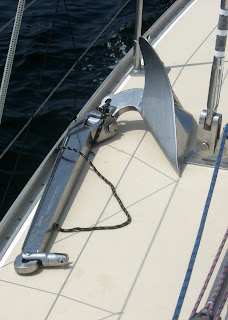
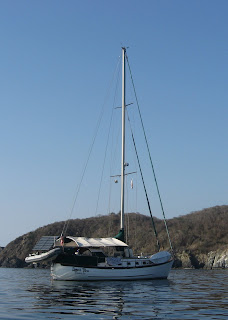 d, it is indeed. We now know of six beautiful sailboats hailing from Telluride out there sailing the seas. When people question us about being from Telluride, The Captain always comments that for Avante
d, it is indeed. We now know of six beautiful sailboats hailing from Telluride out there sailing the seas. When people question us about being from Telluride, The Captain always comments that for Avante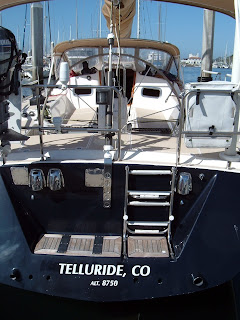




























 ed young, she raised two children on her own and was rewarded with their love. Her greatest rewards and joys, however, were the births of her four grandsons, one granddaughter, and one great granddaughter. Bill and I flew with that great granddaughter out from Arizona to Massachusetts on my mother’s 90th birthday. What better gift could there have been to give her? It proved a fond memory for all of us.
ed young, she raised two children on her own and was rewarded with their love. Her greatest rewards and joys, however, were the births of her four grandsons, one granddaughter, and one great granddaughter. Bill and I flew with that great granddaughter out from Arizona to Massachusetts on my mother’s 90th birthday. What better gift could there have been to give her? It proved a fond memory for all of us.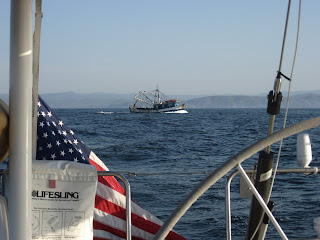



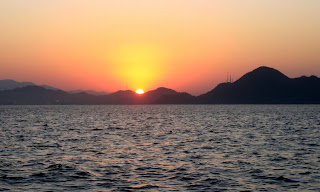




.jpg)
.jpg)
.jpg)

